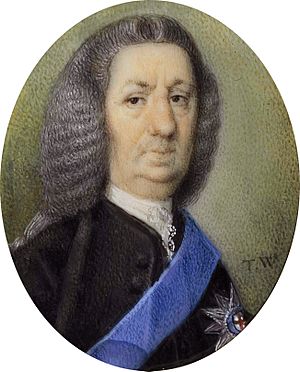Daniel Finch, 8th Earl of Winchilsea facts for kids
Quick facts for kids
The Earl of Winchilsea
|
|
|---|---|

Daniel Finch, 8th Earl of Winchilsea, 3rd Earl of Nottingham, portrait by Thomas Worlidge
|
|
| Lord President of the Council | |
| In office 12 July 1765 – 30 July 1766 |
|
| Monarch | George III |
| Prime Minister | The Marquess of Rockingham |
| Preceded by | The Duke of Bedford |
| Succeeded by | The Earl of Northington |
| Member of the England Parliament for Rutland |
|
| Preceded by | |
| Succeeded by |
|
| Personal details | |
| Born |
Daniel Finch
24 May 1689 |
| Died | 2 August 1769 (aged 80) |
| Resting place | Eastwell, Kent, England |
| Spouses |
|
| Children | 9 daughters |
| Parents | |
Daniel Finch (born May 24, 1689, died August 2, 1769) was an important British politician and a member of the nobility. He held the titles of the 8th Earl of Winchilsea and 3rd Earl of Nottingham. He lived in grand homes like Burley House in Rutland and Eastwell Park in Kent.
Who Was Daniel Finch?
Daniel Finch was the oldest son of Daniel Finch, the 2nd Earl of Nottingham. His mother was Anne Hatton. His father was a well-known politician who supported the Hanoverian royal family. This family came to rule Britain.
When Daniel Finch was young, he was known by the special title Lord Finch. He used this title until 1730, when he inherited his father's higher titles.
His Political Journey
Daniel Finch started his political career at a young age. In 1710, when he was 21, he became a Member of Parliament for Rutland. A Member of Parliament is someone elected to represent people in the government.
From 1725 to 1730, he served as the Comptroller of the Royal Household. This role meant he helped manage the royal family's finances and staff. He kept his seat in Parliament until 1730. That's when he became an Earl and moved to the House of Lords. The House of Lords is another part of the British Parliament, made up of nobles.
In 1739, Daniel Finch supported a very important charity. He helped found the Foundling Hospital in London. This hospital provided a home and education for children who had been abandoned. He was one of the first people to help run it.
Daniel Finch was also involved in different political groups. Even though his father supported a politician named Walpole, Daniel Finch joined a group called the "Patriot Opposition". Later, he became the First Lord of the Admiralty from 1742 to 1744. This meant he was in charge of the British Navy.
He later worked with other political leaders, like the Duke of Newcastle. From 1765 to 1766, he served as Lord President of the Council. This was a very high position, making him a top advisor to the King. In 1752, he received a special honor. He was made a Knight of the Garter, which is one of the most important awards in Britain.
His Family Life
Daniel Finch was married two times.
- His first wife was Lady Frances Feilding. They had one daughter named Lady Charlotte Finch, who never married.
- His second wife was Mary Palmer. With Mary, he had eight daughters. Only four of them lived to be adults:
- Lady Heneage Finch (1741–1820)
- Lady Essex Finch (born 1746)
- Lady Hatton Finch (1747–1829), who also never married.
- Lady Augusta Elizabeth Finch (1751–1797), who never married.
Daniel Finch did not have any sons. This was important for his titles.
His Later Years
Daniel Finch passed away in 1769. He was buried at Eastwell Church, near his home. Since he had no sons, his titles and some of his properties went to his nephew, George Finch, 9th Earl of Winchilsea. George was the son of Daniel's brother, William Finch. Daniel left his properties in Kent, including Eastwell Park, to another nephew, George Finch-Hatton.



